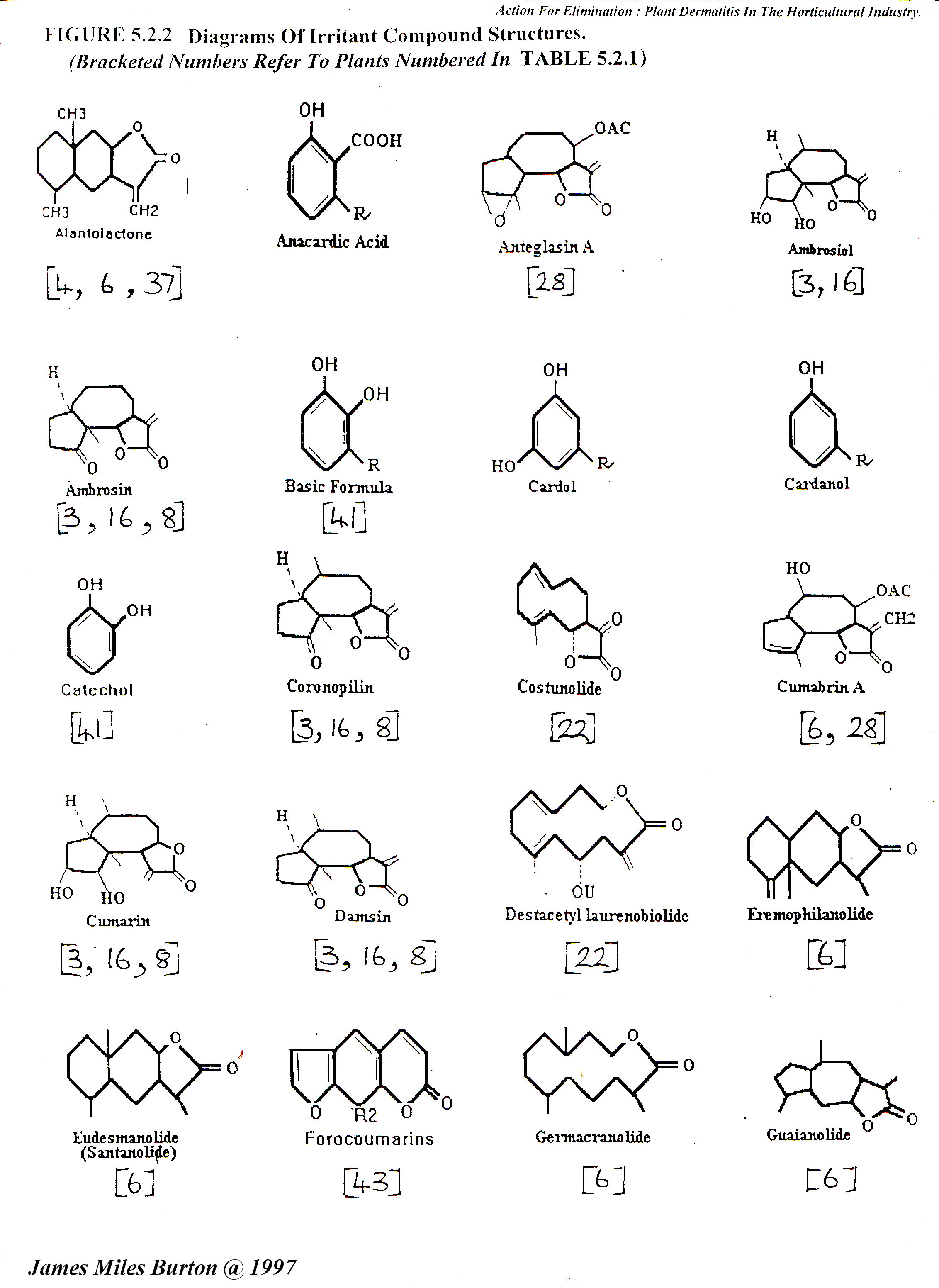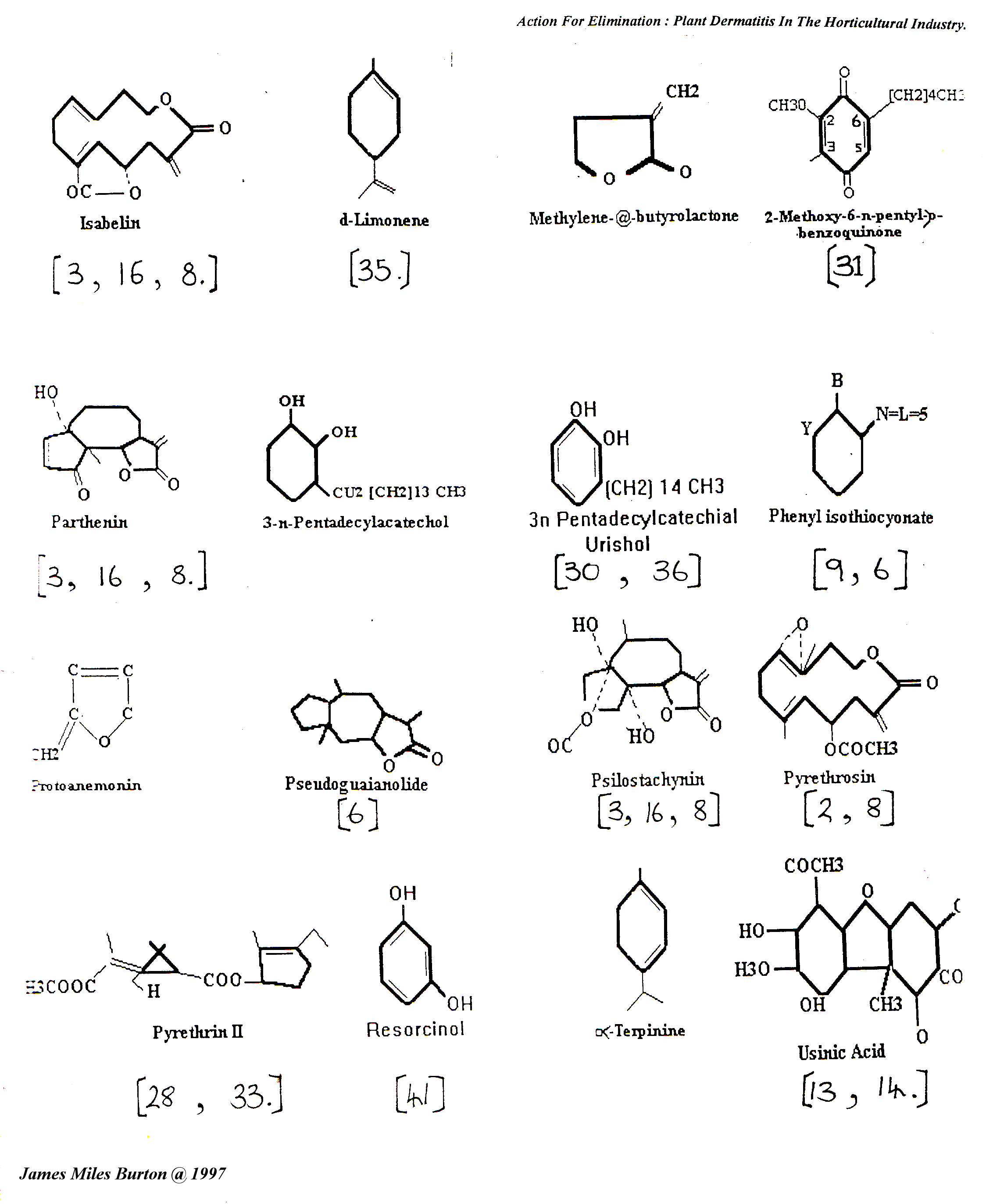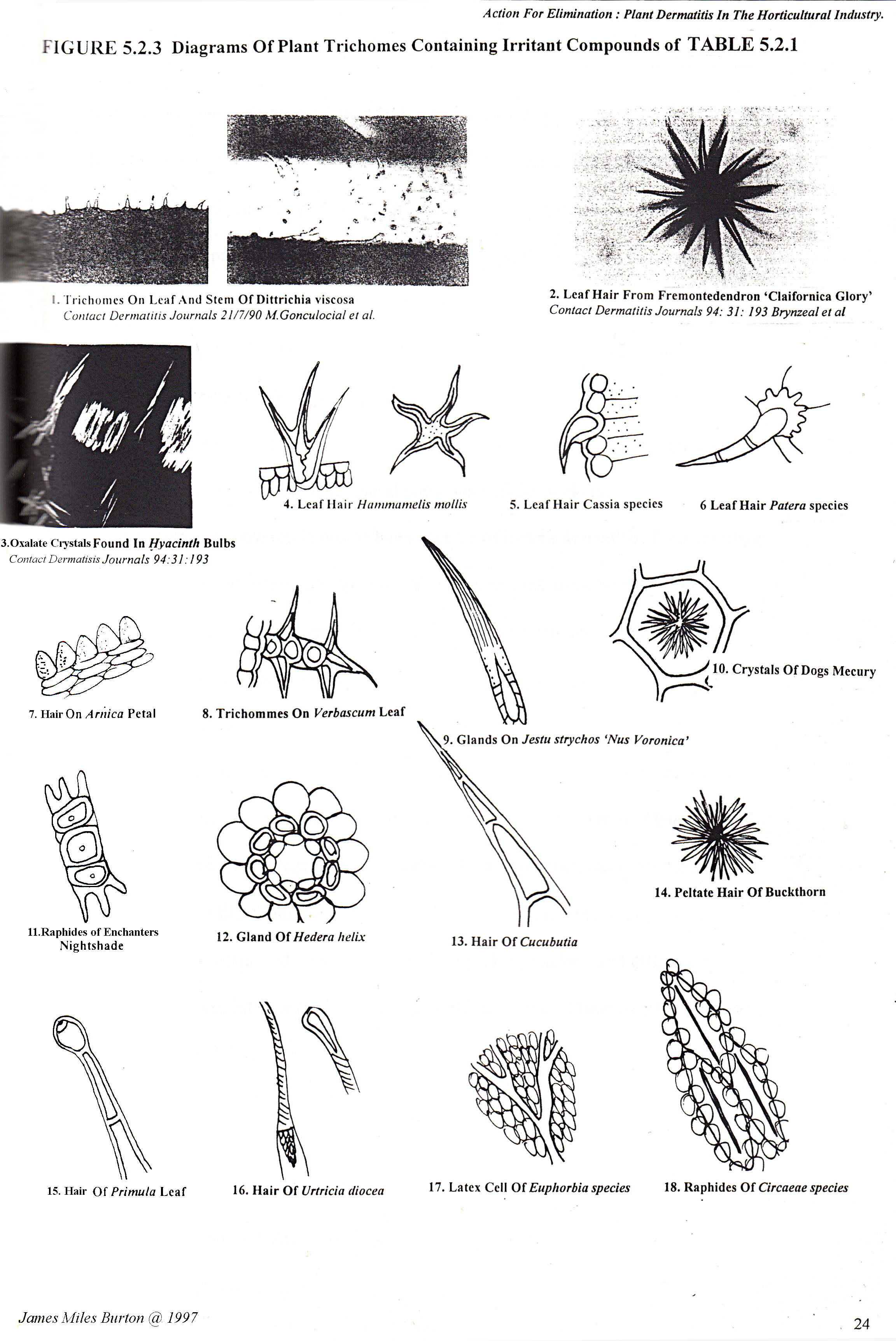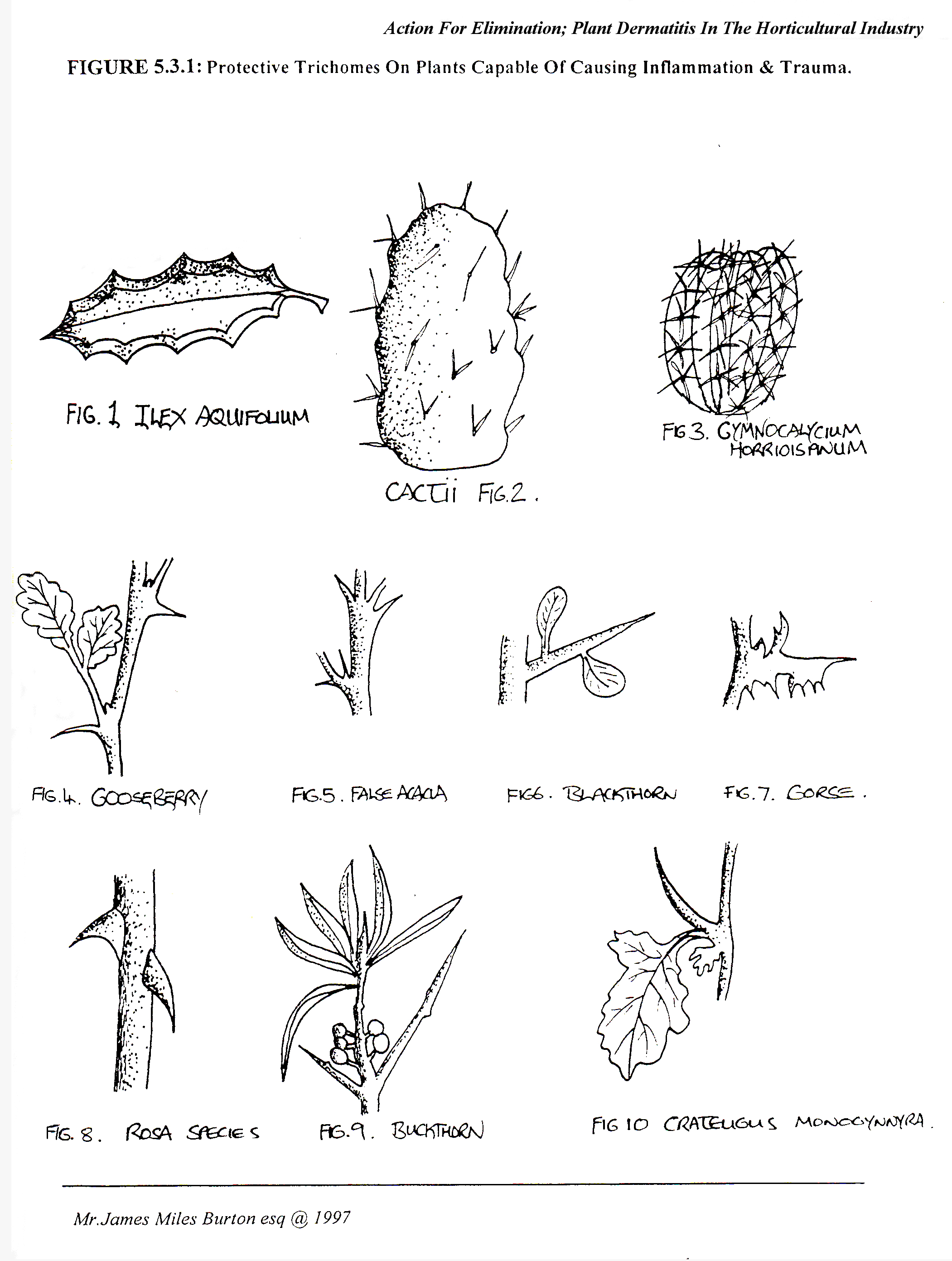Trauma to the skin causing dermatitis may be produced by several factors. The most serious types are caused by the protective organs on plants such as thorns and spines. These may penetrate the skin and cause severe pain and redness around the contact site, rash may follow. Other modified organs contain irritant substances e.g. Utricia in the leaf hairs, where secondary inflammation and dermatitis may be elicited on contact and breaking of these hairs. Most plants commonly encountered however have toxic saps located in all parts of the plant, which may be contacted from general handling. There are many substances which will cause dermatitis including acids, alkalis, phenols. The most important are the Essential and Volatile Oils.
5.1 Typical Chemical Groups Causing Dermatitis [9] [11] [5]
5.1.1 Essential & Volatile Oils [5]
Consists of a mixture of substances, including a mixture of essential oils, terpenees, resins,
phenols and camphors. The potency and amount increase as the plant becomes vigorous in growth.
Essential oil fraction is a major factor in the causes of pollen dermatitis. The essential oils of the oleoresin contain most of the sensitising substances discovered. They ordinarily occur in localised regions of the plant. Predominantly in the flowers, leaves, bark, wood and peel. The essential oils are volatile, non greasy, non saponifying, have a characteristic odour, and can be obtained from plants or their constituents by distillation. Accidental contact occurs from brushing against the plant or crushing the leaves.
500 chemicals have been identified, and are classified into four main groups.
5.1.2 Phenols, aromatic alcohols, and aldehydes
These are the most important to dermatologists. It includes the dihydric phenols, catechols, resorcinols and hydroquinones, many are used for benefit in industry. Substituted catechols such as eugenol and vanillin appear
here also, as sensitizers. Primin C14 H18 O3 is the antigenic substance of Primula, isolated from the hairs.
5.1.3 Terpenes
Have been identified as a sensitising agent in dermatitis and is contained in Citrus, Celery, Pines, Chrysanthemum, Balsams. The oil glands of the orange contain glands from which limocene , terpenes, linalol and others can
be isolated. Lemons skin contain terpenes. Turpentine occurs in pines. The irritant potential varies, and many
may be cross sensitised by other products.
5.1.4 Aliphatic and aromatic esters.
These are Resins and Balsams plant products which may be sensitisers. They are similar in structure and are
acidic secretions of plants. They may also contain gums and oils. The Balsam tree exudes a particular substance which is viscid, and has a cinnamon like odour and contains many simple chemicals such as benzyl benzonate, benyl cinnamate, cinnamic acid, benzonic acid, and vanilla.
5. 1. 5 Substitute benzene hydrocarbons
Vanilla and Vanillin Is a flavouring extract made from the pod of the vanilla plant. It is a crystalline structure. Contact dermatitis due to this substance is frequent in its cultivation. This causes erythremous rash of face and lower extremities. Cinnamon, found in the bark of the cinnamon tree contains oil which has cinnamic aldehyde
and eugenol. Oil of cinnamon is used mainly for flavouring.
5. 2 Primary Chemical Irritants Of Plants [11]
Plants in Table 5.2.1 contain substances which cause direct irritation or sensitisation on contact with the skin as detailed in Figure 5.2.2. These compounds may be present in the sap, crystals, hairs, trichomes of leaves, stems, bark, roots flowers and pollen, as detailed in Figure 5.2.3 Their toxic potential varies with plants, stage of maturation, season, locality, and weather conditions. E.g. Humulus lupus spines containing hop oil will become stiffer during wet weather. The degree of susceptibility in humans varies with their health, condition of the skin,
and period of exposure. They may injure the skin by direct chemical abrasion. No allergic mechanism is involved and if the degree of exposure is sufficiently great, everyone will be affected.
TABLE 5.2.1: Plants And Their Compounds Commonly Causing Dermatitis [11]
1. Anthemis cotula : Sequesterine lacatones.
2. Arnica montana : Sequesterine lacatones.
3.Ambrosia : Six antigens, pollen oil in Ragweed,
13 sequestrine lacatones, 3-carene and à-pinene.
4. Chicorium endiva : Alanto-lactone, sequestrine lacatone.
5. Chilli Peppers : Capsacicin Mustard Oils
6. Chrysanthemum parthenium : Sequestrine lactone allergens reside in essential oils & coccineum, maximum terpenoids. These are parthenolide. alanto-lactone or cumambrin A. Guianolides and Alantolactone,
7. Codiaeum variegatu / tigulum : Phorbolester / Seqestrine lacatone
8. Compositae : Sequestrine lacatones, oleoresins
9. Cruciferae : Isothiocyanates.
10. Cryptocarya vesicant : Cryptopleurine.
11. Daffodil Narcisii : Calcium oxalate crystals
12. Euphorbiaceae : Diterperoid esters 'euphorbin' euphorbioseroid
13. Frullaria : Usinic acid alantolactive
14. Galanthus : " " "
15. Ginko biloba : Fruit contains fatty acids, ginkgoic acid,
which contain Ginkol and hydroginkol.
16. Helianthus : Sequestrine lacatones
17. Helenium : Aromatic resinous globules, flower allergens. sequestrine lacatone.
18. Humulus lupus : Hop oil spines
19. Hyacinth : Calcium oxalate crystals & raphides,
20. Jonquils : " " "
21. Lacttuca sativa : Lacutin.
22. Laurus nobilis : Berries leaves: essential oils an antioxidant.
Roots: laurenobiolide. Leaf Sequestrine lacatone, which are
costunolide, deacetyl laurenobiolide.
23. Lichens: Evernia, Usnea : Lichen, Atranorin, Usinic, Evernic,
Cladonia, Parmelia:: Perlatoic, Fumar, Protocetranic Acids.
24. Maculura pomifera : Photosensitising bergapten.
25. Mucuna pruriens : Mucunain, irritant endopeptidase.
26. Mustard Radish : Glucosied sinigrin
27. Parthenium hysterophorus : 5 sequisterene lacatones. in glandular
trichomes Parthenin active allergen. Ambrosin also.
28. Pineapple : Proteolytic enzyme bromelin, raphides and citric acid.
29. Poison Ivy Oak :Urishol generates hydroxyl radicas by REDOX cycling.
30. Primula obconica : Primulin 2-Methoxy-6-ü-pentyl-p-benzoqunone.
This is primin & glycoside. Quinhydrone present.
31. Primula sinensis, : Saponin, flavones, glycosides
malacoides, variabilis, sequestrine lacatone pyrethrosin
32. Pyrethrum species : Minor allergen Pyrethrin II.
33. Ranunculaceae : Anenome, Delphium :Lacatone protoanemonin
34. Rutaceae : Peel oil contains d-limonene. contains citronellal, geraniol,
lialool. All irritant. also à-turpentine. carotene.
35. Rhus species :Urishol, an oleorasin, pentadecylcatechols,
an 1,2-dihydroxy benzenes.
36. Salvia officionalis. :Alantolactone
37. Sauserra lappa : Root: costus oil. Sequesterine lacatones
38. Streptocarpus : Caffeic acid and cinnamic acid.
39 . Synadenium grantii : Irritant latex.
40. Tagates : Butemylbitiniophene, à-terthienyl, hydroxytremetone
41. Toxidendron species : Urishol
42. Tulipa : Tulipaside, à-methylene-ë-butyrolacaton(Tulipaline A)
43. Umbelliferae : D-limonene. Carrots: olresins of pinene
Carrots, Parsley, terpineol, cineol. Parsip and Celery contains
Celery, Parsnip, fumocumarins.
44. Vanilla plantifolia : Vanillin- crystaline benzaldehyde,
from glucovaniliic. Alcohol gluconiferyl.



Irritation may be produced by spines, thorns, barbs, bristles, hairs, capsules, trichommes, and glochids penetrating the skin. These are modified leaves and stems, which serve to protect the plant against browsing animals. They are found on the leaves and stems of flowering plants. These sharp instruments commonly penetrate the skin deeply causing pain, blood loss, redness, trauma, and then rash and itching.
The initial wound could inflamed from chemicals contained within the protrusion, causing a more severe form of dermatitis.. Grasses, cereals, rice, bamboo have sharp trichommes which may cause urticarial populous in field workers.
Borage herbs are covered in coarse hairs capable of irritant dermatitis. Tropical plants including cacti and palms have spicules. The most serious and common form of mechanical injury is due to the Cactaceae family. Most contain spines in its areolae. Short fuzzy barbs (glochids) 5-8 will be very hard to extract once in the skin. Optunia lingularia glochids, on entering the skin, will cause pain, erythrema and rash after 72 hours, if spines are removed. Retained spines will cause punctum. Some may take 3 months to remove. Nerve paralysis and cystic osteolysis are common. Opunita ficus indica, the cultivated prickly pear, has barbs (glochidia) which can enter the skin and cause eruptions like scabies. Removal is difficult
and usually made by peeling ointment or salicylic acid plasters. It will affect pickers,
packers and distributors. Glochids will get into the clothes, causing swelling all over.
These adaptations can be seen in Figure 5.3.1
FIGURE 5.3.1: Protective Trichomes On Plants Capable Of Causing Inflammation & Trauma
